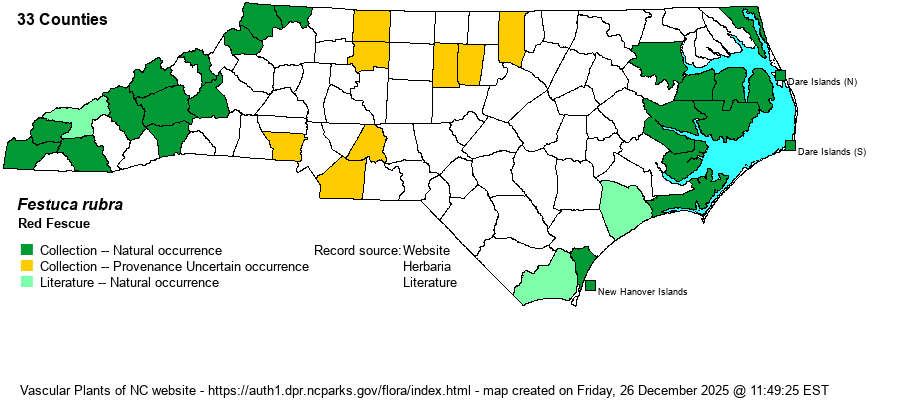| Author | L. | |
| Distribution | Mountains and outer Coastal Plain, including the Outer Banks and barrier islands. Records from the middle part of the state are of uncertain provenance, but likely to be adventive or introduced. Weakley (2020) considers only the montane records as native, but FNA suggests that the Atlantic maritime plants may also be native.
Circumboreal and circumtemperate; in eastern N.A. south to GA and MO. | |
| Abundance | Infrequent to frequent at each end of the state, except scarce in the southern Coastal Plain. Rare to uncommon and perhaps not native in the Piedmont. The website editors suggest a State Rank of S3S4. | |
| Habitat | Exposed places in the Mountains, such as balds, outcrops, and cliffs, but also high elevation mixed forests and seepage bogs. Near the coast, maritime wet or dry grasslands, interdune marshes, brackish marshes, roadsides. Uncertain provenance records (yellow-orange) mostly are from roadsides, powerlines, disturbed soils. | |
| Phenology | Flowering and fruiting April-July. | |
| Identification | As much as anything, Red Fescue is characterized by the rather short (only to 6 inches long), essentially involute (tightly rolled lengthwise), numerous, basal and near-basal leaves. The leaves form a tuft or a bunch, often connected to others to form patches. The inflorescence extends well beyond the leaves, is rather narrow and has short erect or ascending branches. The spikelets each have 3-10 florets, with awns up to 4.5 mm long. | |
| Taxonomic Comments | Many varieties and subspecies have been named, but no one has yet split out material from NC.
Bromus, Festuca, and Poa all can look quite similar to beginners (and even veterans!), because they all have multi-flowered spikelets. Generally speaking, Bromus has much the largest spikelets, and most Poa have a tuft of wispy hairs at the base of each floret (lacking in the other genera). Bromus and Festuca have obvious awns on the florets (absent in Poa). With field experience and careful use of keys, one can eventually handle these genera.
Our annual species of Festuca are by some authors placed in the genus Vulpia; they have a single stamen (vs. perennial and with 3 stamens). | |
| Other Common Name(s) | Creeping Red Fescue | |
| State Rank | [S3S4] | |
| Global Rank | G5 | |
| State Status | | |
| US Status | | |
| USACE-agcp | FACU link |
| USACE-emp | FACU link |

